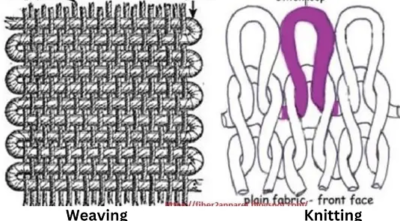Difference Between Woven and Knitted Fabrics
Understanding the differences between woven and knitted fabrics is crucial for selecting the right material for various applications. Here’s a comprehensive comparison to help you distinguish between these two types of fabrics:
-
Knitted Fabrics

Knitted fabrics are made by interlooping yarns using needles. This can be done by hand or with a knitting machine, resulting in fabrics that are typically more elastic and flexible.
Characteristics of Knitted Fabrics
- Structure:
- Knitted fabrics consist of interconnected loops of yarn, which can stretch in all directions.
- Elasticity and Stretch:
- These fabrics are naturally stretchy and can return to their original shape. They offer greater elasticity and flexibility than woven fabrics.
- Comfort:
- Knitted fabrics are generally soft and comfortable, making them ideal for close-fitting garments like t-shirts and underwear.
- Types of Knits:
- Weft Knit: Made by knitting horizontal rows of yarn. Examples include jersey and rib knits.
- Warp Knit: Made by knitting vertical columns of yarn. Examples include tricot and raschel knits.
-
Examples
- Jersey: A weft knit fabric commonly used for t-shirts and dresses.
- Rib Knit: Characterized by vertical ribs, offering excellent stretch, often used in cuffs and collars.
———————————————————————- Difference —————————————————————–
-
Woven Fabrics

Woven fabrics are created by interlacing two sets of yarns at right angles to each other. This method involves a loom, where the yarns are woven together in various patterns.
Characteristics of Woven Fabrics
- Structure:
- Woven fabrics have a crisscross structure, with warp (lengthwise) threads and weft (crosswise) threads.
- Stability and Stretch:
- These fabrics are generally stable and less stretchy compared to knitted fabrics. They have limited elasticity unless elastomeric fibers are added.
- Durability:
- Woven fabrics are typically strong and durable, making them suitable for items that require longevity and stability, such as denim jeans, dress shirts, and upholstery.
-
Examples
- Denim: A strong twill weave used for jeans.
- Chiffon: A lightweight plain weave often used in dresses and blouses
-
Key Differences
- Production Method:
- Woven fabrics are made by interlacing yarns at right angles on a loom. Knitted fabrics are made by inter-looping yarns using needles.

- Elasticity:
- Woven fabrics have limited stretch and are more rigid.
- Knitted fabrics are stretchy and more flexible.
- Durability:
- Woven fabrics tend to be more durable and resistant to wear and tear.
- Knitted fabrics are generally less durable but offer greater comfort and elasticity.
- Applications:
- Woven fabrics are ideal for structured garments and items requiring durability.
- Knitted fabrics are suitable for stretchy, comfortable garments and activewear.

